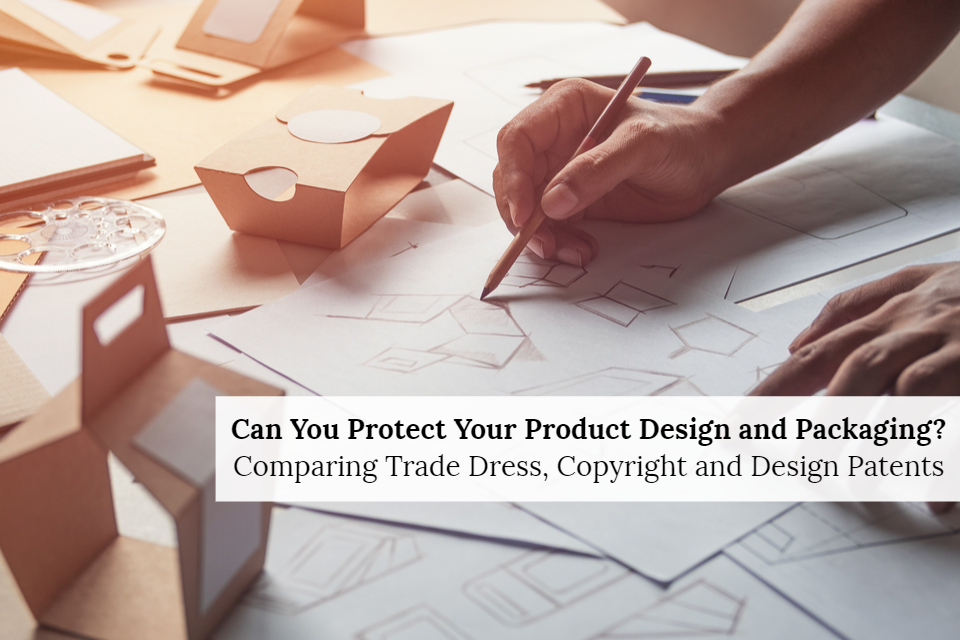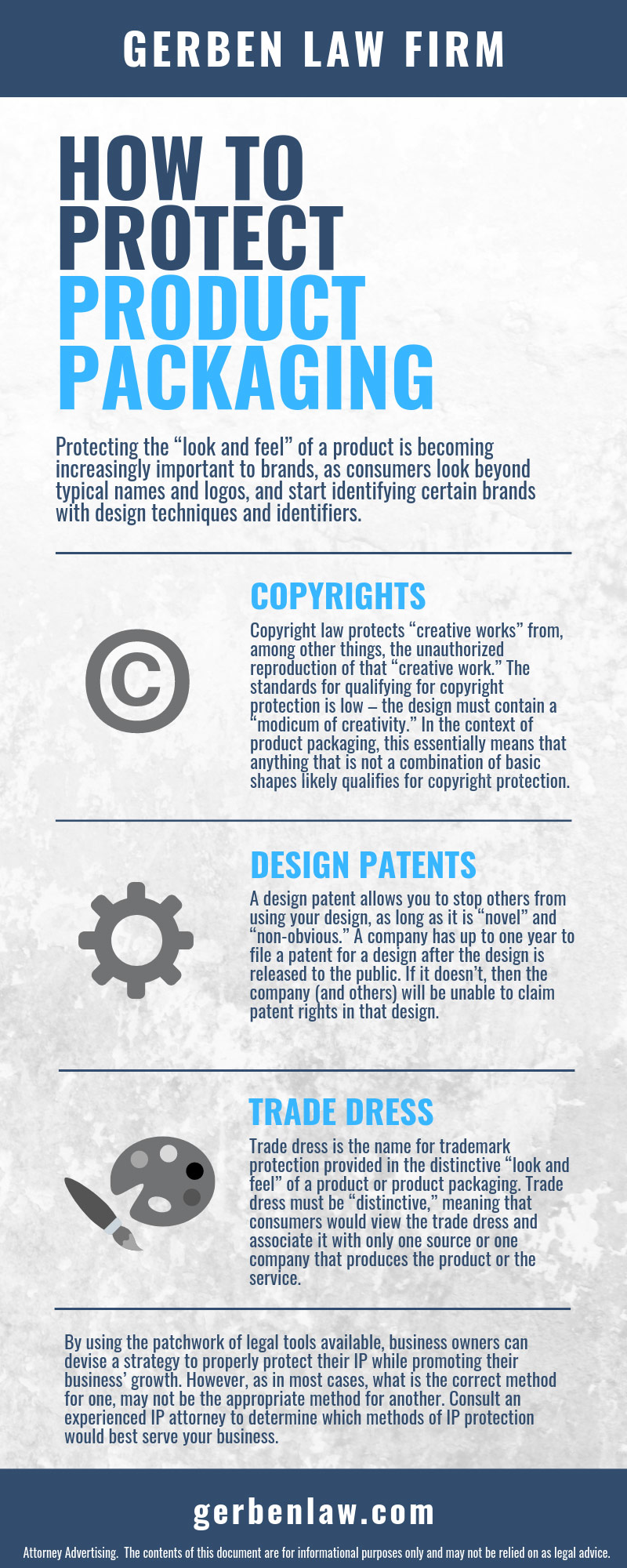How to Protect Product Packaging using Copyrights, Design Patents, and Trade Dress

Many business owners know that names, slogans, and logo can act as trademarks and can give the owner exclusive rights to use that phrase in connection with their products and services.
But how can business owners protect the design and look of their product or product packaging to stop competitors from making similar packaging?
Protecting the “look and feel” of a product is becoming increasingly important to brands, as consumers look beyond typical names and logos, and start identifying certain brands with certain design techniques and identifiers.
There are multiple ways to protect the look of a product using three distinct intellectual property (IP) laws in the United States: copyright law, trade dress law, and design patent law.
But what is the difference and which is right for your business? This article will explore the various types of protections and where to start when selecting ways to protect your IP.
Copyright: Protecting the Look from Reproduction
Copyright law protects “creative works” from, among other things, the unauthorized reproduction of that “creative work.” The standards for qualifying for copyright protection is low – the design must contain a “modicum of creativity.” In the context of product packaging, this essentially means that anything that is not a combination of basic shapes likely qualifies for copyright protection.
So, let’s say you’ve designed an elaborate label for your wine with dozens of design elements in bright, vibrant colors. There is a good chance this could be protected under copyright law.
However, copyright law does not protect functional elements and it only protects the expression of an idea, not the idea itself. So you can protect a copyright in your specific ‘drawing of a sunset’ appearing on your packaging, but you can’t own a copyright in the general idea of a sunset appearing on packaging.
It is therefore a limited protection that is only available for certain labels and other items.
Copyrights are also limited in the scope of their protection. The standard for copyright infringement is that the copy is ‘identical’ or ‘substantially similar.’ This means that if a work is ‘inspired by’ your work, or may share the same themes and overall imagery, but in a different way, it is unlikely that copyright protection will help you protect your product packaging or design.
Copyright protection is a limited protection from the unauthorized reproduction of that copyrighted work. Copyright protection is most powerful when you are trying to prevent others from taking a design and verbatim copying it, such as counterfeiting or piracy.
NEED HELP PROTECTING YOUR PRODUCT PACKAGING?
We are happy to help. Consultations are always complimentary.
Design Patents: Strong Protection for a Limited Time
When most people think of patents, they think of unique inventions. However, patent law also protects product and product packaging designs under what are called “design patents.” A design patent allows you to stop others from using your design, as long as it is “novel” and “non-obvious.”
Unlike trade dress or copyright, a patent only exists after it has been been approved by a U.S. patent examiner with the United States Patent and Trademark Office. A patent examiner will review the design elements in the design patent to see if any part of the design is “functional” and if the design has been used by someone else (evidence of past use is called “prior art.”). If it meets those standards, the examiner will approve it and the patent will issue. A design patent is given protection for 15 years.
One of the biggest limitations of a design patent is that the design must be one that has not been used before – including by the patent holder. A company has up to one year to file a patent for a design after the design is released to the public. If it doesn’t, then the company (and others) will be unable to claim patent rights in that design.
Also, the standard for infringement on a design patent is that the infringer used the same or substantially similar design. This is similar to the copyright standard (above) but more narrow than the standard for trade dress.
Design patents can only be filed up to one year after the design is made public. However, it can help establish rights in a design that may not contain copyrightable elements but does not have the required distinctiveness to qualify for trade dress protection.
Trade Dress: Infinite Protection for Distinctive Designs
Trade dress is the name for trademark protection provided in the distinctive “look and feel” of a product or product packaging. However, it can also be used to protect distinct store layouts, color schemes, textures, sounds, and much more.
Of the three methods of protection, trade dress is by far the most powerful, but it is only available to distinctive designs. This means that it is not enough to have a “modicum of creativity” like in copyright law, or be “novel” and “non-obvious” like in patent law.
Trade dress must be “distinctive,” meaning that consumers would view the trade dress and associate it with only one source or one company that produces the product or the service.
This is a high-bar and only available to trade dress that is sufficiently exclusive, but also has a large impact in the minds of consumers.
Trade dress provides protection against ‘confusingly similar’ designs but the owner must show that its mark is distinctive – a high bar when it comes to stopping others from using a product design or packaging.
Conclusion
By using the patchwork of legal tools available, business owners can devise a strategy to properly protect their IP while promoting their business’ growth. However, as in most cases, what is the correct method for one, may not be the appropriate method for another. Consult an experienced IP attorney to determine which methods of IP protection would best serve your business.
(click to open / download)
Do you need assistance with a trademark matter?
Contact an Attorney Today